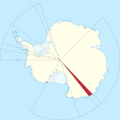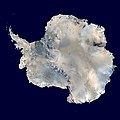Terre Adélie-Kraton
The Terre Adélie Kraton , represents a fragment of Kraton in East Antarctica . It occurs over a length of approx. 400 kilometers on the coastal area of Adélieland and George V Land and on the Georg V coast . Presumably larger areas are hidden under the mighty Antarctic ice sheet .
Map of Antarctica and surrounding waters
Location of Adélieland
Satellite image of the Antarctic ice sheet
The development of the Terre Adélie craton spans a period of approx. 2520 million years (abbreviated mya ) to approx. 1700 mya. From the supercontinent Columbia , this craton was connected to the Australian Gawler craton.
Geological development and structure
The multi-phase geodynamic development of the Terre Adélie craton can be traced back from approx. 2520 mya ( Neoarchean ) to approx. 1700 mya ( Paleoproterozoic ). The Kraton area is structured into an eastern and a western province.
The eastern province is dominated by a neo-archaic basement . It consists of felsic to mafic orthogneiss and granodiorites , which intruded into the overlying terrestrial metasediments . These 2550 to 2440 mya old magmatites occur in two separate tectonic zones, which originate from deep and medium crustal depths. During a neoarchaic orogenic phase, the rocks from the deeper crustal area were under granulitic , while those from medium depths were metamorphically overprinted under amphibolitical conditions . Within the eastern province there is a paleoproterozoic sedimentary basin . The eastern province is bounded by two shear zones . The eastern one forms the border to the rest of the East Antarctic basement, the western to the western province.
In the western province a paleoproterozoic basin was formed. It consists of metapelitic migmatisierten gneisses, low share metagreywackes and different volcanic and igneous rocks. The oldest parent rocks date from 2400 to 2200 mya, with 2800 mya old zircons . The sedimentation phase in this basin was short and took place from 1720 mya. Around 1690 mya metamorphoses , partial rock melts ( anatexis ), accompanied by mafic magma intrusions occurred. These periods correspond to the Kimban orogeny.
Age, petrography of the rocks and the tectono-thermal processes correlate with those of the Australian Gawler craton. Therefore, the Terre Adélie craton is considered to be part of the Gawler craton of Proto-Australia.
Geological framework
Hypothetical paleogeography of the supercontinent Columbia about 1590 million years ago
The Mawson continent with the components Mawson-Kraton, Gawler-Kraton and the Terre Adélie-Kraton on the coastal area of George V Land
In reconstructions of the supercontinent Columbia , the land masses of the Mawson Craton , the Gawler Craton and the Terre Adélie Craton were tectonically connected. They are known as the Mawson continent . The separation began in the Upper Jurassic around 160 mya with the separation of Proto-Eastern Gondwana from Proto-Australia.
Web links
- Simon L. Harley, Ian CW Fitzsimons and Yue Zhao: Antarctica and supercontinent evolution: historical perspectives, recent advances and unresolved issues. In: Geological Society, London, Special Publications, 383, 1-34, 9 October 2013. doi: 10.1144 / SP383.9 , alternative
- MH Monroe: Antarctica - Before and After Gondwana. In: Australia: The Land Where Time Began, A biography of the Australian continent. Online article
- Evgeny Mikhalsky: Main Stages and Geodynamic Regimes of the Earth's Crust Formation in East Antarctica in the Proterozoic and Early Paleozoic. In: Geotectonics, 2008, Vol. 42, No. 6, pp. 413-429. doi: 10.1134 / S0016852108060010 , alternatively
Individual evidence
- ↑ RP Menot, G. Duclaux, JJ Peucat, Y. Rolland, S. Guillot and other: Geology of the Terre Adélie Craton (135 - 146˚ E). In: US Geological Survey and The National Academies; USGS OF-2007-1047, Short Research Paper 048. doi: 10.3133 / of2007-1047.srp048 , alternative
- ^ A b Justin L. Payne, Martin Hand, Karin M. Barovich, Anthony Reid and David AD Evans: Correlations and reconstruction models for the 2500-1500 Ma evolution of the Mawson Continent. In: Palaeoproterozoic Supercontinents and Global Evolution, Geological Society, London, Special Publications, 323, 319-355. doi: 10.1144 / SP323.16 , PDF
- ↑ The Gawler Craton is an extensive region of Archaean to Mesoproterozoic crystalline basement underlying approximately 440,000 km² of central South Australia. In: Geology of South Australia. Online article
- ^ Anthony J. Reid, Stacey O. McAvaney, and Geoff L. Fraser: Nature of the Kimban Orogeny across northern Eyre Peninsula. In: MESA Journal 51 December 2008. PDF
- ↑ Nick MWRoberts: The boring trillion? - Lid tectonics, continental growth and environmental change associated with the Columbia supercontinent. In: Geoscience Frontiers, Volume 4, Issue 6, November 2013, Pages 681-691. doi: 10.1016 / j.gsf.2013.05.004 , alternatively
- ↑ Simon E. Williams, Joanne M. Whittaker and R. Dietmar Müller: Full-fit reconstructions of the southern Australian margin and Antarctica - implications for correlating geology between Australia and Antarctica. In: Outcome document from the Eastern Australasian Basins Symposium IV, Brisbane, QLD, September 10-14, 2012. PDF




